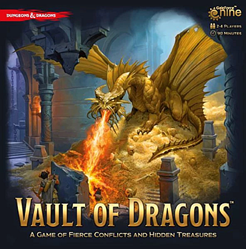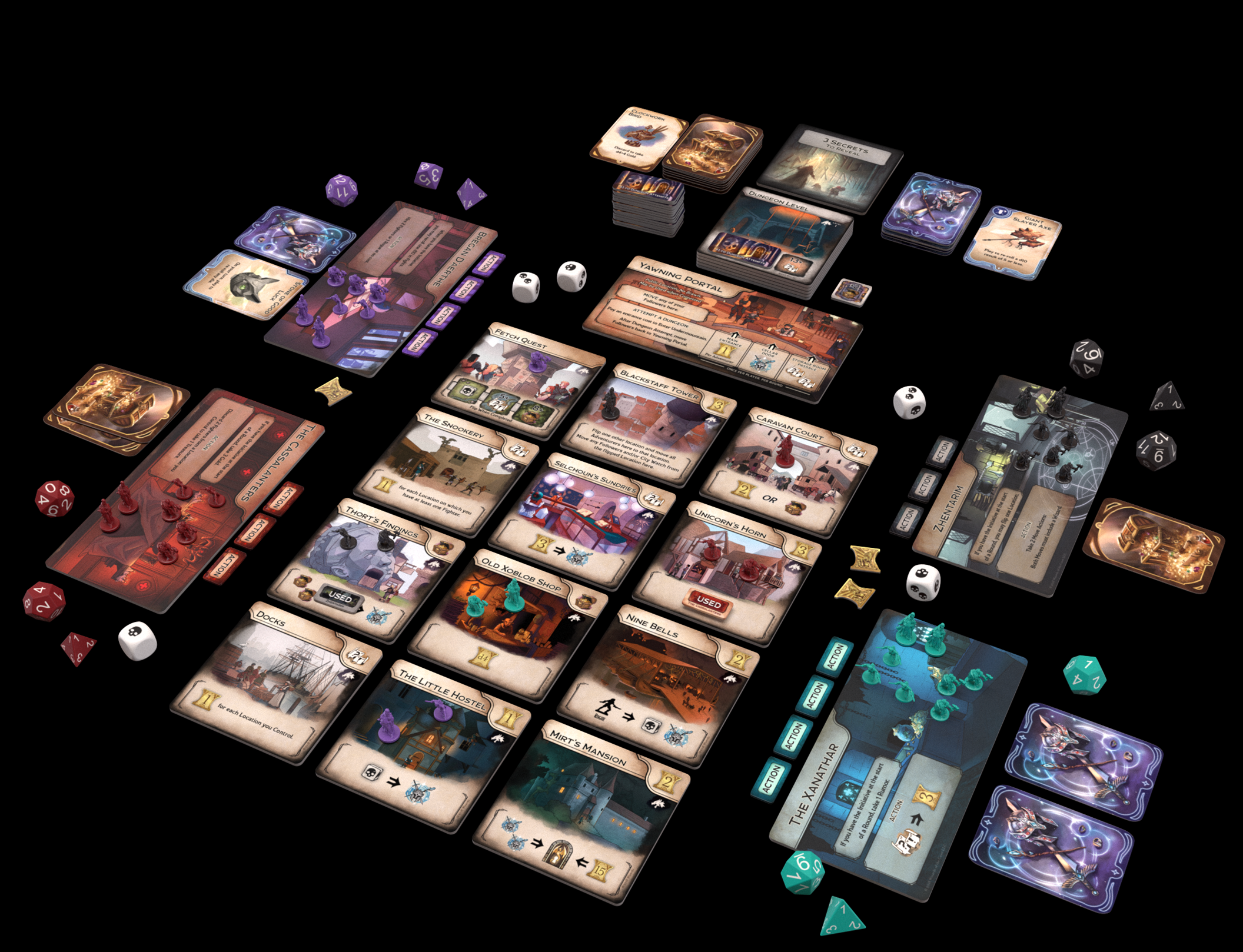 I had a chance to play the new D&D-themed game Vault of Dragons from Gale Force Nine on the weekend; some friends played it just before. All of us found it a tremendously frustrating experience, partly due to a poor rulebook, but mostly due to tedious game play.
I had a chance to play the new D&D-themed game Vault of Dragons from Gale Force Nine on the weekend; some friends played it just before. All of us found it a tremendously frustrating experience, partly due to a poor rulebook, but mostly due to tedious game play.
The concept of the game is that you control one of four factions racing to find a hidden vault full of gold coins (“Dragons” in D&D lore) before your competitors. It ties in very nicely to the current Waterdeep season and the adventure Dragon Heist; the factions you can control here (Zhentarim, the Xanathar, Bregan D’aerthe and Asmodeaus Cult) correspond to the potential villains in the adventure.
I believe the game mechanics are based on GF9’s previous release, Sons of Anarchy, which is well-regarded. This game is unlikely to be so well-regarded.
Your goal is to be the first to find and loot the Vault of Dragons. This requires you to recruit a team of adventurers (made up of Fighters, Rogues and Wizards) and gather enough Secrets, Rumours, treasures and magic items to have a shot of defeating the vault. Defeating the Vault requires a roll of 20 or higher, on a four, ten or twelve-sided die. As you can see, you’ll need quite a number of bonuses to your roll to even have a chance of succeeding.
There are three main ways of gaining the resources you need.
One is by using your actions to visit locations on the city grid (twelve locations) and activate their effects. Typical effects include drawing a rumour, paying gold for a magic item, or discarding magic items for a secret. However, you can’t activate a location if its contested, which means another player or the City Watch are present.
A second is by controlling the locations at the end of the turn; each location you control gives you some resource: gold, rumours, magic items or treasure. A couple of locations have negative effects if you control them.
The final method is to delve into a dungeon, which work as lesser versions of the Vault of Dragons: make dice rolls based on which of your followers are present, spend resources to add to you roll, and gain rewards based on how high you rolled. You’ll likely also take casualties. Defeating a dungeon (rolling the highest result) always grants you a secret, which gives a +1 bonus on all future dungeon expeditions, but also increases the number of casualties you take when you essay one. You can also gain other resources, even if you didn’t defeat the dungeon. Typically, you make a roll on the casualty die and lose that many figures (0, 1 or 2) whenever you attempt a dungeon – rewards only come if you have some survivors.
If a location is contested, you have two choices: move away and let your opposition have it, or fight! The fighting procedure is the same as for dungeons. Highest roll wins, various cards modify the rolls, and there can be casualties inflicted as well, based on a die rolled by rogues or due to another game effect. If you win, your opposition have to move away and you can activate the location without using another action. On a failure, you’ve got to move away.
Each faction has a special action they can perform, and a special ability they gain if they are the first player; first player is determined at the end of each turn based on the number of locations you control.
Recruiting new fighters, rogues and wizards takes an action and some gold. It’s relatively easy to do, although it’s possible to run out of gold and get into a lot of trouble that way; spending one action to take a gold seems a poor use of your actions. So, try to avoid that.
The basics of the game, trying to control the city with your followers and gain bonuses, is pretty good. The trouble is that when you add in the dungeon-delving, it dilutes the play significantly. All of a sudden, you’re in a push-your-luck game where someone who is lucky can take prizes more quickly than someone who isn’t, which is frustrating. I’m fine with push-your-luck games, but the key feature about most of those is that they’re fast. This game didn’t feel so, and our initial play lasted significantly past the 90 minutes advertised on the box.
Drawing treasure and magic item cards that don’t give permanent bonuses to your fighting and dungeon-delving effects feels frustrating. Remember the target of 20 on a dice roll to win the game? Some magic items give a +1 to the roll, others allow a reroll, while many have unrelated uses. You roll one die per class of character present: a d12 for a Wizard, a d10 for a Fighter, and a d4 for a Rogue, but take only the highest roll. Any casualty dice you roll, either due to a rogue being present, a card effect, or a “critical hit” also add to your total, but that’s likely only to be a +2 at most. Rumours can be discarded to give +1 to the roll as well, and these may be quite significant.
The dungeon expeditions give purpose to your efforts on the city board, but for us it turned into a tedious cycle of building up resources on the main board, going to the Yawning Portal to attempt the dungeon, then repeating. You didn’t want to force too many confrontations with other players in the city because you’re worrying about your losses in the next dungeon expedition. In addition, you needed to take your adventurers away from the city to attempt the dungeon.
It also doesn’t help that the rules are poorly realised. That first game played by my friends? They didn’t realise they gained a secret each time they succeeded at a dungeon, so the game just dragged. Even once I read the rules – a task I’m more familiar with – I kept getting frustrated by their haphazard state. The rules for Fighting are referenced in three places, but with exceptions each time. Trying to work out exactly what the rules meant when they described exploring the rooms of a dungeon was a challenge.
To add to the confusion, there’s one building that allows you to flip other city locations. A little booklet included with the game helpfully lists the locations. This could be very nice if more of the play was focused on the city board, but the dungeon remained the best place to get secrets and so the players spent much time there.
The components are nice, though. Little plastic miniatures for your followers, and thick cardboard tokens and tiles with good art.
That day, I also played several games of Tyrants of the Underdark. That game, designed by Peter Lee, Rodney Thompson and Andrew Veen, is a very good game, playing fast and with lots of tactical opportunities. Vault of Dragons had a lot of actions for little effect, dungeon runs that took too long to resolve, and lots of ways to frustrate the players. Thematically, a lot of the game works very well with the story line of the Dragon Heist adventure, but it doesn’t have that adventure’s excitement. Not recommended.

